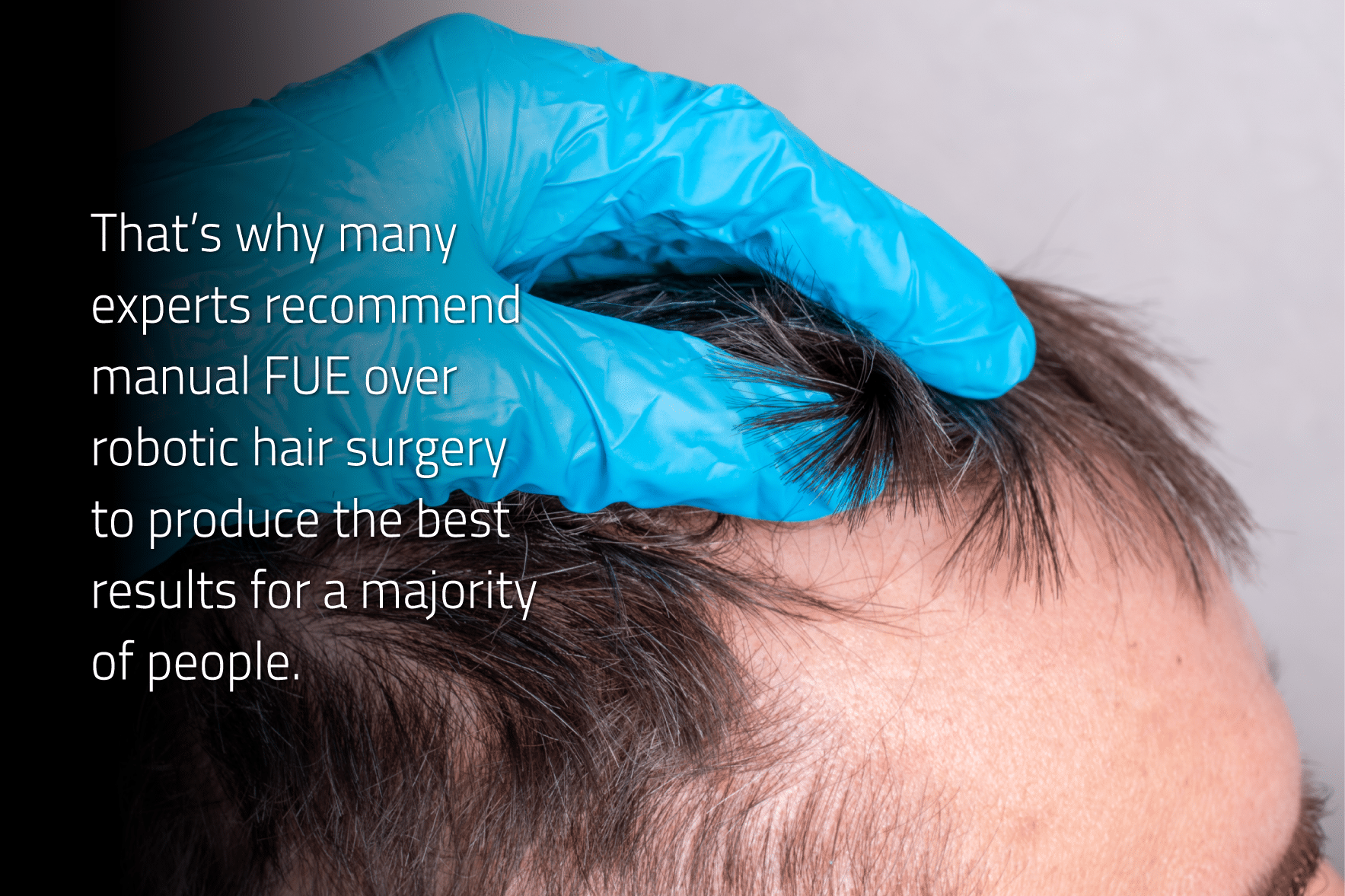People with hair loss considering hair transplant surgery usually like to do a bit of research beforehand.
If that’s you, and you’ve been surfing the web looking at the different types of hair restoration procedures, you may have seen something about robotic hair transplant methods like ARTAS.
With so much information out there, it can be difficult to know which hair transplant procedure might be best, and whether having a robotic procedure or a hair restoration surgery done using manual techniques is better.
To help you decide, let’s get some things about today’s hair restoration surgery options clear first.
What is the Best Type of Hair Transplant?
While there are some important variations and different techniques used, the gold standard for modern hair restoration is widely considered to be FUE, or follicular unit extraction.
Follicular unit extraction surgery can be performed as either a Shaved FUE or No-Shave FUE procedure, depending on whether the client wants to avoid shaving the donor and graft sites for the surgery.
The FUE hair transplant method involves extracting individual hair follicles in small groups known as follicular units and surgically placing them in the areas where new hair growth is desired.
Both Shaved and Shave-Less FUE have largely replaced the older FUT (follicular unit transplantation, also known as strip transplantation) method because they can produce
Traditionally, FUE procedures are performed by a skilled hair transplant surgeon assisted by a highly trained surgical support team.
What are Robotic Hair Transplants?
Robotic hair transplants are usually FUE procedures where a special robotic arm, using an optical guidance system, harvests the follicular units from the donor site.
This differs from a regular FUE procedure, where the graft harvesting is done manually, by either a skilled surgeon or by specially trained surgical techs.
Robot-assisted FUE fully automates the graft extraction process using a complex algorithm that decides where to cut on the basis of visual data.
This advanced technology is touted as allowing great speed and precision during the graft excision portion of the hair transplant procedure.
Are There Drawbacks to Robotic Hair Transplants?
While the idea of a computer-controlled robotic arm speeding up the follicular unit extraction process sounds alluringly high-tech, the technology does have some limitations.
Cons of Robotic Hair Transplants:
- Not ideal for light hair. Robotic optical systems rely on contrast to “see” which follicles to harvest, making them a poor choice for those with fair, blonde or grey hair — and potentially for those with darker skin tones. Lighter hair can sometimes be dyed before the procedure, but this is an extra step and not an ideal solution for many.
- Best used on straight hair. The optical system has trouble seeing individual hair follicles in those with non-straight hair. For this reason, the system cannot reliably be used on patients with curly or ethnic-textured hair.
- Higher transection rates. A good transection rate for FUE is under 3%, according to the International Society of Hair Restoration Surgery. While transection rates for manually harvested grafts vary somewhat with skill and technique, the average transection rate for robotically harvested hair follicles is considerably higher, at 6.6%. The result is lower follicular viability, increased donor site depletion, and higher potential cost.
In addition to these issues, the automated nature of robotic hair transplant technology has led many hair restoration clinics to increasingly rely on unsupervised surgical techs, who may lack the expertise and experience needed for the best outcomes.
This can lead to worse results for patients and the need for repeat – or even corrective – hair transplant procedures.
So be sure to ask exactly who will be performing your hair transplant procedure, and whether a board certified surgeon will be involved at every step.
Why Having a Medical Team Perform Your Hair Transplant Can Produce Better Results
While robotic hair transplant technology can do some things well, it has its limitations.
That’s why many experts recommend manual FUE over robotic hair surgery to produce the best results for a majority of people.

Having an experienced surgical team performing your whole hair transplant procedure – from planning to follicular extraction to graft placement – can produce better and more reliable outcomes for a wider variety of patients.
Here’s why:
- An expert team helmed by a skilled surgeon can perform procedures on patients of all ethnicities and those with different hair colors and textures.
- Skilled surgeons and their highly trained surgical techs can adapt to individual patient variations, including unique follicular depths, differences in skin elasticity and thickness, and more.
- An experienced hair restoration surgeon brings an aesthetic sensibility that a robot cannot match, producing natural-looking results by carefully selecting follicular units that match natural hair growth patterns, hair density, and texture.
- A skilled medical team working in concert can avoid high transection rates by using optimal techniques during harvesting and ensuring prompt placement after extraction.
A Medical Team You Can Trust
The best hair transplant teams combine advanced surgical technique and artistry to give their hair transplant patients a natural-looking, fuller head of hair.
At North Atlanta Hair Restoration, your hair restoration surgery will be performed from start to finish by a highly skilled medical team led by our founder Dr. Daniel A. Danyo, MD, MBA.
Dr. Danyo and his medical team will be integrally involved in your full surgical care.
As one of 250 doctors who hold the title of Diplomate from the American Board of Hair Restoration Surgery – the only recognized certification for hair restoration surgeons — he is a leading expert at the forefront of his field.
Dr. Danyo is ably assisted in his surgeries by highly trained physicians’ assistants and skilled surgical technicians, who work in concert to achieve unparalleled levels of skill, precision and speed.
This veteran medical team is able to undertake grafts of a much larger size than many others – all without outsourcing any of it to a robotic machine.
They use state of the art technology, tools and techniques to achieve transformative results for their clients, but every step of the process is done by a human.
Atlanta’s Best Hair Restoration Doctor and Team
Let our team help guide you through the hair restoration process.
Dr. Danyo will assess your case personally, answer your questions, provide expert recommendations and help you take the next steps to reversing your hair loss.
Don’t wait – call us today at 678-845-7521 or book online to schedule a virtual or in-person consultation.

